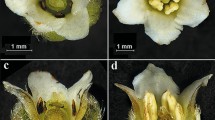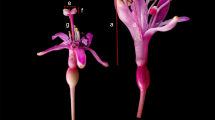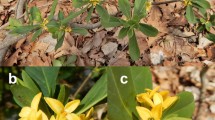Abstract
Key message
Through a multidisciplinary study we found that Gymnocalycium bruchii, an endemic cactus from central Argentina, acts as a dioecious species, which is the first record in this genus.
Abstract
Cactaceae species are typically hermaphroditic; however, about 2% have other different reproductive systems. These non-hermaphroditic species may develop sexual dimorphism in flowers or other reproductive, vegetative or ecological traits, besides a specific breeding system and floral ontogeny. Therefore, multidisciplinary research is necessary to fully understand reproduction in those species. For this purpose, we studied Gymnocalicium bruchii, a globose cactus endemic to central Argentina that is presumably dioecious or gynodioecious. We made observations in two natural and two cultivated populations. We made morphological observations of plants and flowers, and performed quantitative analyses to determine the sex ratio, size of plants and flowers, flower production, fruiting, among other variables. We performed hand-pollination, self-fertilization and free-pollination tests to determine the breeding system. Finally, we studied the anatomy and ontogeny of the reproductive organs using permanent histological slides of flower morphs at different stages. Our results confirm that Gymnocalicium bruchii is a dioecious species. Female flowers have atrophied anthers and a functional gynoecium that produces fruits and seeds. Male flowers are bigger and have a functional androecium but a sterile gynoecium. In the cultivated population, the sex ratio was 1/1, whereas the number of male individuals was higher in both natural populations. Pollination tests corroborated dioecy. Ontogenetic studies revealed that in female flowers the anthers collapse before microspore maturation, while in male flowers the gynoecium shows normal development of the ovary, style, stigma, and ovules; however, the latter are never fertilized.







Similar content being viewed by others
References
Aliscioni NL, Delbón NE, Gurvich DE (2021) Spine function in Cactaceae, a review. JPACD 23:1–11
Arakaki M, Christin PA, Nyffeler R, Lendel A, Eggli U, Ogburn RM, Spriggs E, Moore MJ, Edwards J (2011) Contemporaneous and recent radiations of the world’s major succulent plant lineages. Proc Natl Acad Sci USA 108:8379–8384. https://doi.org/10.1073/pnas.1100628108
Baker M (2006) A new florally dimorphic hexaploid, Echinocereus yavapaiensis sp. nov. (section Triglochidiatus, Cactaceae) from central Arizona. Plant Syst Evol 258:63–83. https://doi.org/10.1007/s00606-005-0390-9
Bauk K, Gurvich DE, Las Peñas ML (2022) Cytogenetic characteristics of four Gymnocalycium (Cactaceae) species along altitudinal gradients. Haseltonia, in press
Buhanan ML, Briggs JM (2010) Phenotypic Plasticity in response to short term nutrient availability in Cylindropuntia fulgida (Cactaceae). Haseltonia 16:91–100. https://doi.org/10.2985/1070-0048-16.1.91
Callejas-Chavero A, Vargas-Mendoza CF, Gomez-Hinostrosa C, Arriola-Padilla VJ, Cornejo-Romero A (2021) Breeding system in a population of the globose cactus Mammillaria magnimamma at Valle del Mezquital, Mexico. Bot Sci 99:229–241. https://doi.org/10.17129/botsci.2654
Ceballos C, Ferrero C, Aliscioni NL, Las Peñas ML, Gurvich DE (2022) Do larger plants produce more and better seeds and seedlings? Testing the hypothesis in a globose cactus, Wigginsia sessiliflora. Botany 100:849–855. https://doi.org/10.1139/cjb-2022-0063
Charles G (2009) Gymnocalycium in habitat and culture. Ketton, Standford, UK
Charlesworth D (2006) Evolution of plant breeding systems. Curr Biol 16:726–735
Del Castillo RF, Argueta ST (2009) Reproductive implications of combined and separate sexes in a trioecious population of Opuntia robusta (Cactaceae). Am J Bot 96:1148–1158. https://doi.org/10.3732/ajb.0800301
Delgado-Ramírez V, Camacho-Velázquez A, Vázquez-Santana S (2021) Biología reproductiva de Thelocactus leucacanthus ssp. schmollii (Cactaceae), un cactus microendémico de Querétaro. México Bot Sci 99:791–806. https://doi.org/10.17129/botsci.2798
Demaio PH, Barfuss MHJ, Kiesling R, Till W, Chiapella JO (2011) Molecular phylogeny of Gymnocalycium (Cactaceae): assessment of alternative infrageneric systems, a new subgenus, and trends in the evolution of the genus. Am J Bot 98:1841–1854. https://doi.org/10.3732/ajb.1100054
Díaz L, Cocucci AA (2003) Functional gynodioecy in Opuntia quimilo (Cactaceae), a tree cactus pollinated by bees and hummingbirds. Pl Biol 5:531–539. https://doi.org/10.1055/s-2003-44783
Fernández G, Stiefkens L, Las Peñas L, Pérez A, Delbón N (2020) Morfo-anatomía del perigonio, gineceo y fruto en Trichocereus candicans y T. seudocandicans (Cactaceae), implicancias taxonómicas y reproductivas. Bol Soc Argent Bot 55:557–572. https://doi.org/10.31055/1851.2372.v55.n4.29068
Fleming TH, Maurice S, Buchmann SL, Tuttle MD (1994) Reproductive biology and relative male and female fitness in a trioecious cactus, Pachycereus pringlei (Cactaceae). Am J Bot 81:858–867. https://doi.org/10.1002/j.1537-2197.1994.tb15567.x
Flores-Rentería L, Orozco-Arroyo G, Cruz-García F, García-Campusano F, Alfaro I, Vázquez-Santana S (2013) Programmed cell death promotes male sterility in the functional dioecious Opuntia stenopetala (Cactaceae). Ann Bot 112:789–800. https://doi.org/10.1093/aob/mct141
Giorgis MA, Astegiano J, Cingolani AM, Gurvich DE (2015) Flowering phenology, fruit set and seed mass-number trade-off of five co-existing Gymnocalycium (Cactaceae) species from Córdoba Mountains, Argentina. J Torrey Bot Soc 142:220–230. https://doi.org/10.3159/TORREY-D-14-00017.1
Goettsch B, Hilton-Taylor C, Cruz-Piñón G, Duffy JP, Frances A et al (2015) High proportion of cactus species threatened with extinction. Nature Plants 1:1–7. https://doi.org/10.1038/nplants.2015.142
Gurvich DE (2019) The use of herbicides in South America dry forests to control shrub encroachment: a new threat to cactus species? A first assessment. Haseltonia 26:39–42. https://doi.org/10.2985/026.026.0106
Gurvich DE, Zeballos SR, Demaio PH (2014) Diversity and composition of cactus species along an altitudinal gradient in the Sierras del Norte Mountains (Córdoba, Argentina). S Afr J Bot 93:142–147. https://doi.org/10.1016/j.sajb.2014.03.018
Gurvich DE, Demaio PH, Cingolani AM, Giorgis MA (2022) Do microhabitat segregation explains coexistence of globose cactus species? Haseltonia 28:42–47. https://doi.org/10.2985/026.028.0105
Gutiérrez-Flores C, Cota-Sánchez JH, León-de la Luz JL, García-De León FJ (2017) Disparity in floral traits and breeding systems in the iconic columnar cactus Pachycereus pringlei (Cactaceae). Flora 235:18–28. https://doi.org/10.1016/j.flora.2017.08.007
Hernández-Cruz R, Barrón-Pacheco F, Sánchez D, Arias S, Vázquez-Santana S (2018) Functional dioecy in Echinocereus: ontogenetic patterns, programmed cell death, and evolutionary significance. Int J Plant Sci 179:257–274. https://doi.org/10.1086/697072257
Hernández-Cruz R, Silva-Martínez J, García-Campusano F, Cruz-García F, Orozco-Arroyo G, Alfaro I, Vázquez-Santana S (2019) Comparative development of staminate and pistillate flowers in the dioecious cactus Opuntia robusta. Plant Reprod 32:257–273. https://doi.org/10.1007/s00497-019-00365-w
Hoffman MT (1992) Functional dioecy in Echinocereus coccineus (Cactaceae): breeding system, sex ratios, and geographic range of floral dimorphism. Am J Bot 79:1382–1388. https://doi.org/10.1002/j.1537-2197.1992.tb13748.x
Koenig WD (2021) A brief history of masting research. Phil Trans R Soc B 376:20200423. https://doi.org/10.1098/rstb.2020.0423
Kraus J, De Sousa H, Rezende M, Castro N, Vecchi C, Luque R (1998) Astra blue and basic fuchsin double staining of plant materials. Biotech Histochem 73:235–243. https://doi.org/10.3109/10520299809141117
Leite Montalvão AP, Kersten B, Fladung M, Müller NA (2021) The diversity and dynamics of sex determination in dioecious plants. Front Plant Sci 11:580488. https://doi.org/10.3389/fpls.2020.580488
Mandujano MC, Plasencia López L, Aguilar Morales G, Jiménez Guzmán G, Galicia-Pérez A, Rojas-Aréchiga M, Martínez-Peralta C (2014) Sistema sexual de Opuntia tomentosa Salm-Dyck (Cactaceae, Opuntioideae) en un pedregal de origen volcánico. Cact Suc Mex 59:100–120
Martínez-Peralta C, Márquez-Guzmán J, Mandujano MC (2014) How common is self-incompatibility across species of the herkogamous genus Ariocarpus? Am J Bot 101:530–538. https://doi.org/10.3732/ajb.1400022
Martino P, Gurvich ED, Las Peñas ML (2022) Dna content and cytogenetic characteristics of Gymnocalycium quehlianum (Cactaceae) along an altitudinal gradient. bag. Journal of Basic and Applied Genetics XXXIII 1:51–59
Meregalli M, Ercole E, Rodda M (2010) Molecular phylogeny vs. morphology: shedding light on the infrageneric classification of Gymnocalycium (Cactaceae). Schumannia 6:257–275
Muyle A, Martin H, Zemp N, Mollion M, Gallina S, Tavares R, Silva A, Bataillon T, Widmer A, Glemin S, Touzet P, Marais G (2020) Dioecy is associated with high genetic diversity and adaptation rates in the plant genus Silene. Mol Biol Evol 38:805–811. https://doi.org/10.1093/molbev/msaa229
Nyffeler R, Eggli U (2010) A farewell to dated ideas and concepts: molecular phylogenetics and a revised suprageneric classification of the family Cactaceae. Schumannia 6:109–149. https://doi.org/10.5167/uzh-43285
Ohya I, Nanami S, Itoh A (2017) Dioecious plants are more precocious than cosexual plants: a comparative study of relative sizes at the onset of sexual reproduction in woody species. Ecol Evol 7:5660–5668. https://doi.org/10.1002/ece3.3117
Orozco-Arroyo G, Vázquez-Santana S, Camacho A, Dubrovsky JG, Cruz-García F (2012) Inception of maleness: auxin contribution to flower masculinization in the dioecious cactus Opuntia stenopetala. Planta 236:225–238. https://doi.org/10.1007/s00425-012-1602-5
Pannell JR (2017) Sex determination in plants. Curr Biol 27:191–197
Perotti SB, Aliscioni NL, Delbón NE, Perea M, Hammann A, Gurvich DE (2022) Biomass partitioning and morphoanatomical traits of six Gymnocalycium (Cactaceae) species that inhabit through a precipitation gradient. Diversity 14:749. https://doi.org/10.3390/d14090749
Pimienta-Barrios E, del Castillo RF (2002) Reproductive biology. In: Nobel PS (ed) Cacti biology and uses. University of California Press, Berkeley, pp 75–90
R Core Team (2022) R: A language and environment for statistical computing. R Foundation for Statistical Computing, Vienna, Austria. URL https://www.R-project.org/
Ramadoss N, Orduño-Baez A, Portillo C, Steele S, Rebman J, Flores-Rentería L (2022) Unraveling the development behind unisexual fowers in Cylindropuntia wolfi (Cactaceae). BMC Plant Biol 22:94. https://doi.org/10.1186/s12870-022-03431-0
Sánchez D, Vázquez-Santana S (2018) Embryology of Mammillaria dioica (Cactaceae) reveals a new male sterility phenotype. Flora 241:16–26. https://doi.org/10.1016/j.flora.2018.02.007
Strittmatter LI, Negrón-Ortiz V, Hickey RJ (2002) Subdioecy in Consolea spinosissima (Cactaceae): breeding system and embryological studies. Am J Bot 89:1373–1387. https://doi.org/10.3732/ajb.89.9.1373
Strittmatter LI, Negrón-Ortiz V, Hickey RJ (2006) Comparative microsporangium development in male-fertile and male-sterile flowers of Consolea (Cactaceae): when and how does pollen abortion occur. Grana 45:81–100. https://doi.org/10.1080/00173130500537101
Strittmatter LI, Hickey RJ, Negrón-Ortiz V (2008) Heterochrony and its role in sex determination of cryptically dioecious Consolea (Cactaceae) staminate flowers. Bot J Linn Soc 156:305–326. https://doi.org/10.1111/j.1095-8339.2007.00754.x
Wheelwright NT, Logan BA (2004) Previous-year reproduction reduces photosynthetic capacity and slows lifetime growth in females of a neotropical tree. PNAS 101:8051–8055. https://doi.org/10.1073/pnas.0402735101
Wilson WG, Harder LD (2003) Reproductive uncertainty and the relative competitiveness of simultaneous hermaphroditism versus dioecy. Am Nat 162:220–241
Wu HM, Cheung AY (2000) Programmed cell death in plant reproduction. Programmed Cell Death in Higher Plants. 23–37
Zarlavsky G (2014) Histología Vegetal: técnicas simples y complejas. 1era ed. Sociedad Argentina de Botánica, Gráfica Arte, Buenos Aires
Acknowledgements
Jorgelina Brasca assisted with the English version of this manuscript.
Funding
FONCyT (Fondo para la Investigación Científica y Tecnológica. Agencia Nacional de Promoción de la Investigación, el Desarrollo Tecnológico y la Innovación, Grants Nos 2016-0077 and 2017-0220), SECyT (Secretaría de Ciencia y Tecnología. Universidad Nacional de Córdoba) and Research Committee of the Cactus and Succulent Society of America.
Author information
Authors and Affiliations
Corresponding authors
Ethics declarations
Conflict of interest
The authors have no relevant financial or non-financial interests to disclose.
Additional information
Publisher's Note
Springer Nature remains neutral with regard to jurisdictional claims in published maps and institutional affiliations.
Supplementary Information
Below is the link to the electronic supplementary material.
Rights and permissions
Springer Nature or its licensor (e.g. a society or other partner) holds exclusive rights to this article under a publishing agreement with the author(s) or other rightsholder(s); author self-archiving of the accepted manuscript version of this article is solely governed by the terms of such publishing agreement and applicable law.
About this article
Cite this article
Delbón, N.E., Aliscioni, N.L., Lorenzati, M. et al. Looking for non-hermaphrodite cacti: multidisciplinary studies in Gymnocalycium bruchii endemic to central Argentina. Plant Reprod 37, 201–214 (2024). https://doi.org/10.1007/s00497-023-00461-y
Received:
Accepted:
Published:
Issue Date:
DOI: https://doi.org/10.1007/s00497-023-00461-y




